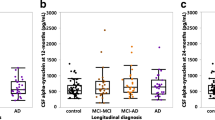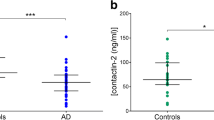Abstract
Several studies show increased levels of zinc (Zn) in the Alzheimer’s disease (AD) brain. More recently, alterations in synaptic Zn and Zn transporter proteins (ZnT) have been implicated in the accumulation of amyloid plaques in an animal model of AD. To determine if alterations in ZnT proteins are present in AD brain, we measured levels of ZnT-1, the protein responsible for export of Zn to the extracellular space in the amygdala (AMY), hip-pocampus/parahippocampal gyrus (HPG), superior and middle temporal gyrus (SMTG), inferior parietal lobule (IPL), and cerebellum (CER) of 19 AD and 14 age-matched control subjects. To determine if alterations of ZnT-1 occur early in the progression of AD, we analyzed protein levels in the HPG, SMTG and CER of 5 subjects with mild cognitive impairment (MCI), 5 subjects with early AD (EAD) and 4 appropriately age-matched controls. Western blot and dot-blot analysis showed statistically significant (p <0.05) elevations of ZnT-1 in AD AMY, HPG, and IPL and significantly depleted ZnT-1 in AD SMTG compared to age-matched control subjects. We also observed statistically significant elevations of ZnT-1 in the HPG of EAD subjects compared with controls. In contrast to late-stage AD subjects, ZnT-1 levels were significantly decreased in HPG of subjects with MCI and were significantly elevated in the SMTG of both MCI and EAD subjects compared with age-matched controls. Correlation analysis of ZnT-1 levels and senile plaque (SP) and neurofibrillary tangle (NFT) counts in the AMY and CA1 and subiculum of AD HPG showed a significant (p <0.05) positive correlation with SP counts and a trend towards a significant (p = 0.12) positive correlation with NFT counts in AMY. Overall, our results show alterations in one of the key proteins responsible for maintenance of Zn homeostasis early in the progression of AD suggesting that alterations in Zn balance could be involved in the pathogenesis of neuron degeneration and amyloid deposition in AD.
Similar content being viewed by others

References
Aging, National Institute on (1995) Progress Report on Alzheimer’s disease. Washington, D.C., NIA.
Aging, National Institute on (1997) National institute on aging and Reagan institute working group on diagnostic criteria for the neuropathological assessment of Alzheimer’s disease.Neurobiol. Aging 18(S4), S1-S2.
Assaf SY and SH Chung (1984) Release of endogenous Zn2+ from brain tissue during activity.Nature 308, 734–736.
Bettger WJ and BL O’Dell (1981) A critical physiological role of zinc in the structure and function of biomembranes.Life Sci. 28, 1425–1438.
Bush AI, WH Pettingell, G Multhaup, M Dparadis, JP Vonsattel, JF Gusella, K Beyreuther, CL Masters and RE Tanzi (1994) Rapid induction of Alzheimer A beta amyloid formation by zinc.Science 265, 1464–1467.
Choi DW (1996) Zinc neurotoxicity may contribute to selective neuronal death following transient global cerebral ischemia.Cold Spring Harbor Symp. Quant. Biol. 61, 385–387.
Cole TB, HJ Wenzel, KE Kafer, PA Schwartzkroin and RD Palmiter (1999) Elimination of zinc from synaptic vesicles in the intact mouse brain by disruption of the ZnT3 gene.Proc. Natl. Acad. Sci. USA 96, 1716–1721.
Cuajungco MP and GJ Lees (1997) Zinc metabolism in the brain: relevance to human neurodegenerative disorders.Neurobiol. Dis. 4, 137–169.
Danscher G, G Howell, J Perez-Clausell and N Hertel (1985) The dithizone, Timm’s sulphide silver and the selenium methods demonstrate a chelatable pool of zinc in CNS. A proton activation (PIXE) analysis of carbon tetrachloride extracts from rat brains and spinal cords intravitally treated with dithizone.Histochemistry 83, 419–422.
Danscher G, KB Jensen, CJ Frederickson, K Kemp, A Andreasen, S Juhl, M Stoltenberg and R Ravid (1997) Increased amount of zinc in the hippocampus and amygdala of Alzheimer’s diseased brains: a proton-induced X-ray emission spectroscopic analysis of cryostat sections from autopsy material.J. Neurosci. Meth. 76, 53–59.
Deibel MA, WD Ehmann and WR Markesbery (1996) Copper, iron, and zinc imbalances in severely degenerated brain regions in Alzheimer’s disease: possible relation to oxidative stress.J. Neurol. Sci. 143, 137–142.
Deng QS, GC Turk, DR Brady and QR Smith (1994) Evaluation of brain element composition in Alzheimer’s disease using inductively coupled plasma mass spectrometry.Neurobiol. Aging S113, 464.
Dong J, CS Atwood, VE Anderson, SL Siedlak, MA Smith, G Perry and PR Carey (2003) Metal binding and oxidation of amyloid-beta within isolated senile plaque cores: Raman microscopic evidence.Biochemistry 42, 2768–2773.
Ebadi M, PL Iversen, R Hao, DR Cerutis, P Rojas, HK Happe, LC Murrin and RF Pfeiffer (1995) Expression and regulation of brain metallothionein.Neurochem. Int. 27, 1–22.
Ehmann WD, WR Markesbery, M Alauddin, TI Hossain and EH Brubaker (1986) Brain trace elements in Alzheimer’s disease.Neurotoxicology 7, 195–206.
Frederickson CJ, MA Klitenick, WI Manton and JB Kirkpatrick (1983) Cytoarchitectonic distribution of zinc in the hippocampus of man and the rat.Brain Res. 273, 335–339.
Frederickson CJ, SW Suh, D Silva and RB Thompson (2000) Importance of zinc in the central nervous system: the zinc-containing neuron.J. Nutr. 130, 1471S-1483S.
Gaskin F, Y Kress, C Brosnan and M Bornstein (1978) Abnormal tubulin aggregates induced by zinc sulfate in organotypic cultures of nerve tissue.Neuroscience 3, 1117–1128.
Golden BE (1988) Zinc in cell division and tissue growth: Physiological aspects, InZinc in Human Biology (Mills CF, Ed.) (Springer-Verlag:London).
Haug FM (1967) Electron microscopical localization of the zinc in hippocampal mossy fibre synapses by a modified sulfide silver procedure.Histochemie 8, 355–368.
Huang L and J Gitschier (1997) A novel gene involved in zinc transport is deficient in the lethal milk mouse.Nat. Genet. 17, 292–297.
Huang X, CS Atwood, RD Moir, MA Hartshorn, JP Vonsattel, RE Tanzi and AI Bush (1997) Zinc-induced Alzheimer’s Abeta1-40 aggregation is mediated by conformational factors.J. Biol. Chem. 272, 26464–26470.
Jo SM, MH Won, TB Cole, MS Jensen, RD Palmiter and G Danscher (2000) Zinc-enriched (ZEN) terminals in mouse olfactory bulb.Brain Res. 865, 227–236.
Kambe T, Y Yamaguchi-Iwai, R Sasaki and M Nagao (2004) Overview of mammalian zinc transporters.Cell. Mol. Life Sci. 61, 49–68.
Kirschke CP and L Huang (2003) ZnT7, a novel mammalian zinc transporter, accumulates zinc in the Golgi apparatus.J. Biol. Chem. 278, 4096–4102.
Lovell MA, JD Robertson, WJ Teesdale, JL Campbell and WR Markesbery (1998) Copper, iron and zinc in Alzheimer’s disease senile plaques.J. Neurol. Sci. 158, 47–52.
Manev H, E Kharlamov, T Uz, RP Mason and CM Cagnoli (1997) Characterization of zinc-induced neuronal death in primary cultures of rat cerebellar granule cells.Exp. Neurol. 146, 171–178.
Markesbery WR, FA Schmitt, RJ Kryscio, DG Davis, CD Smith and DR Wekstein (2005) The neuropathologic substrate of mild cognitive impairment.Arch. Neurol. (in press).
McKhann G, D Drachman, M Folstein, R Katzman, D Price and EM Stadlan (1984) Clinical diagnosis of Alzheimer’s disease: report of the NINCDS-ADRDA Work Group under the auspices of Department of Health and Human Services Task Force on Alzheimer’s Disease.Neurology 34, 939–944.
Mirra SS, A Heyman, D McKeel, SM Sumi, BJ Crain, LM Brownlee, FS Vogel, JP Hughes, G van Belle and L Berg (1991) The Consortium to Establish a Registry for Alzheimer’s Disease (CERAD). Part II. Standardization of the neuropathologic assessment of Alzheimer’s disease.Neurology 41, 479–486.
Morris JC, A Heyman, RC Mohs, JP Hughes, G van Belle, G Fillenbaum, ED Mellits and C Clark (1989) The Consortium to Establish a Registry for Alzheimer’s Disease (CERAD). Part I. Clinical and neuropsychological assessment of Alzheimer’s disease.Neurology 39, 1159–1165.
Palmiter RD (1995) Constitutive expression of metallothionein-III (MT-III), but not MT-I, inhibits growth when cells become zinc deficient.Toxicol. Appl. Pharmacol. 135, 139–146.
Palmiter RD and SD Findley (1995) Cloning and functional characterization of a mammalian zinc transporter that confers resistance to zinc.Embo J. 14, 639–649.
Palmiter RD, SD Findley, TE Whitmore and DM Durnam (1992) MT-III, a brain-specific member of the metallothionein gene family.Proc. Natl. Acad. Sci. USA 89, 6333–6337.
Palmiter RD, TB Cole and SD Findley (1996a) ZnT-2, a mammalian protein that confers resistance to zinc by facilitating vesicular sequestration.Embo J. 15, 1784–1791.
Palmiter RD, TB Cole, CJ Quaife and SD Findley (1996b) ZnT-3, a putative transporter of zinc into synaptic vesicles.Proc. Natl. Acad. Sci. USA 93, 14934–14939.
Perez-Clausell J (1996) Distribution of terminal fields stained for zinc in the neocortex of the rat.J. Chem. Neuroanat. 11, 99–111.
Perez-Clausell J and G Danscher (1985) Intravesicular localization of zinc in rat telencephalic boutons. A histochemical study.Brain Res. 337, 91–98.
Perez-Clausell J and G Danscher (1986) Release of zinc sulphide accumulations into synaptic clefts afterin vivo injection of sodium sulphide.Brain Res. 362, 358–361.
Petersen RC, GE Smith, SC Waring, RJ Ivnik, EG Tangalos and E Kokmen (1999) Mild cognitive impairment: clinical characterization and outcome.Arch. Neurol. 56, 303–308.
Samudralwar DL, CC Diprete, BF Ni, WD Ehmann and WR Markesbery (1995) Elemental imbalances in the olfactory pathway in Alzheimer’s disease.J. Neurol. Sci. 130, 139–145.
Vallee BL (1995) The function of metallothionein.Neurochem. Int. 27, 23–33.
Vallee BL and KH Falchuk (1993) The biochemical basis of zinc physiology.Physiol. Rev. 73, 79–118.
Wenstrup D, WD Ehmann and WR Markesbery (1990) Trace element imbalances in isolated subcellular fractions of Alzheimer’s disease brains.Brain Res. 533, 125–131.
Williams RJP (1989) An introduction to the biochemistry of zinc, InZinc in Human Biology, (Mills CF, Ed.), (Springer-Verlag: London), pp 15–31.
Author information
Authors and Affiliations
Corresponding author
Rights and permissions
About this article
Cite this article
Lovell, M.A., Smith, J.L., Xiong, S. et al. Alterations in zinc transporter protein-1 (ZnT-1) in the brain of subjects with mild cognitive impairment, early, and late-stage alzheimer’s disease. neurotox res 7, 265–271 (2005). https://doi.org/10.1007/BF03033884
Received:
Revised:
Issue Date:
DOI: https://doi.org/10.1007/BF03033884



